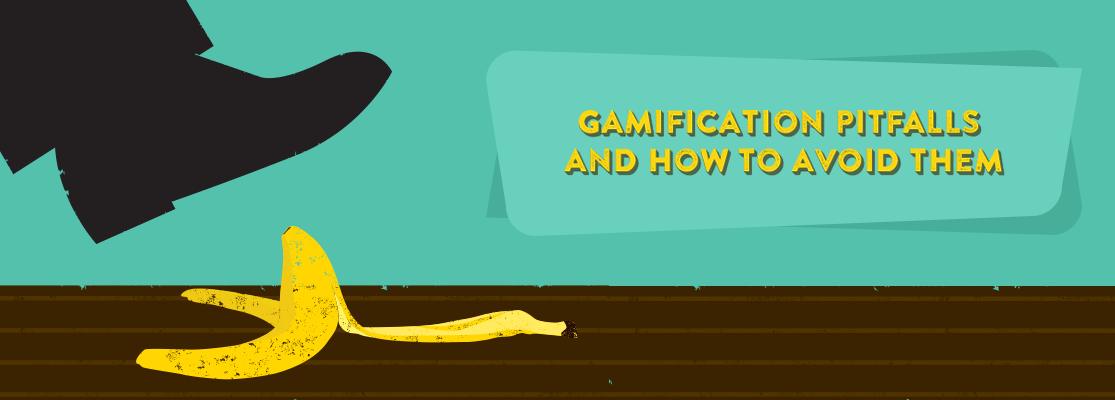4 GAMIFICATION PITFALLS AND HOW TO AVOID THEM
Gamification gets people excited like no other strategy does, probably because it holds the promise of fun and engagement, and extraordinary results. This is mostly true, since research backs it up, and there are experts who swear by the effectiveness of this tool.
But beware… gamification is no peril-free zone. When it is not thought through and designed well, it can have the exact opposite effect of what was intended. Here are a few pitfalls to watch out for:
1. Superficial Engagement
It’s great to have people falling over themselves to earn goodies, or competing on the leaderboard to achieve top position, but if these are the only reasons that spur learners to perform the desired behaviors, then it’s not going to last very long. Extrinsic motivators can only go so far to engage and motivate. Once the novelty wears off, people tend to lose interest and fall back into their old habits. If you are not sure if this is the case, try offering a chocolate to a seven year old to do a boring task. Very soon, you will notice that the chocolate is taken for granted, and you will have to increase the ‘prize’ to keep her motivated at the task.
How to avoid superficial engagement, and promote deep engagement:
- Make sure to have more intrinsic motivators than extrinsic motivators. In the above example, an indefinitely better option would be to make the task itself interesting, or if that is not possible, convince the child of its value to her.
2. Unintended Consequences
While encouraging and rewarding the right behaviors does definitely motivate people, sometimes unintended, and even undesirable behaviors can be the side effects of a gamification initiative.
Take the case of the Cobra Effect, for instance, a term that originated in colonial India. Concerned about the rise in venomous cobra snakes in Delhi, the British government offered a bounty for every dead cobra. The strategy proved successful initially, resulting in a large number of snakes being killed. However, enterprising people soon began gaming the system, breeding cobras for the extra income. Realizing this, the government scrapped the program, which further compounded the problem, because the cobras were now worthless, causing them to be released. The British government was not the only victim of the Cobra Effect – there are many other examples we can learn from.
How to avoid unintended consequences:
- Think long and hard about the motivators, rewards, and consequences. Here again, make sure that extrinsic motivators like physical rewards and cash incentives are applied very carefully.
3. Rewarding the Wrong Behaviors
Referred to as Kerr’s Folly, this is a common problem that we unfortunately see existing all around us. Instances of an organization wanting to promote teamwork, but rewarding individual star performers, talking about establishing a service culture, but rewarding quick completion of customer complaint calls, wishing for more ideas and innovation, but penalizing people for mistakes, the list goes on.
A typical occurrence of Kerr’s Folly in the L&D and training industries is… yes, you guessed it! Measuring and rewarding completion of a course, rather than the effectiveness of learning and subsequent transfer to the workplace.
How to avoid rewarding the wrong behaviors:
- Be clear about the goal and the outcomes you are aiming for.
- Measure and reward what is important (the goal and the outcomes), not what is easy.
4. Rewards that Users Don’t Find Valuable
Have you ever received a gift from someone, presented with a lot of love, and struggled to tell them that you don’t really like it, or find much use for it? That’s exactly what would happen if we throw a bunch of worthless badges at our users, without thinking about whether they would find these badges valuable.
Google learned this the hard way when they introduced the Google Reader service. Zappos did the same with their user profile pages. What both companies didn’t think about was the WIIFM (What’s In It For Me)? What can users do with those badges? While Google allowed people to display the badges on their Google+ profile pages, they did not think about the reason why a person would want to do so. People don’t typically want to brag about having read a bunch of articles on a news site.
How to avoid offering worthless rewards to users:
- Think about whether the audience will find your rewards useful / exciting
I’m sure there are many other perils and pitfalls to watch out for, and I’ve just scratched the surface here. I welcome your thoughts, suggestions or additions. Please add them in the Comments section below.
Here are some of our recent articles on gamification:
- Blog Series on Gamification by Karl Kapp
- “Play to Learn” with Karl Kapp
- A Review of Duolingo (the Language Learning App)
Looking to implement gamified learning in your organization? Please get in touch with us at elearning@learnnovators.com.
Written by Srividya Kumar
(Co-Founder at Learnnovators)
_________________________________
Published on 17-Nov-2017






